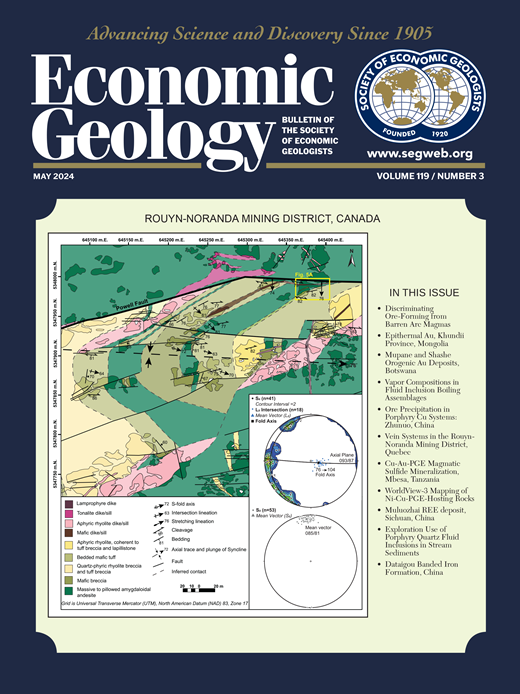伊朗Mehdiabad巨型铅锌矿床重晶石特征及成因
IF 4.9
1区 地球科学
Q1 GEOCHEMISTRY & GEOPHYSICS
引用次数: 0
摘要
Mehdiabad是世界上最大的密西西比河谷型(MVT) Zn-Pb矿床(3.94亿吨金属矿石,锌含量为4.2%,Pb含量为1.6%),并含有重要的重晶石资源(40亿吨)。如此大规模的重晶石聚集在碳酸锌矿床中并不常见。因此,重晶石的成因及其与铅锌矿化的关系值得进一步研究。野外工作和岩石学研究表明,Mehdiabad矿床的锌铅钡矿体为下白垩统Taft组和Abkuh组碳酸盐岩单元。细粒至粗粒重晶石,含少量菱铁矿,形成于三个阶段(S1、S2和S4),伴随着石英硫化物阶段(S3),含少量石英、闪锌矿、方铅矿、黄铜矿和黄铁矿,以及主要的锌铅硫化物阶段(S5),含大量闪锌矿和方铅矿。重晶石δ34S值为17.7 ~ 20.6‰,δ18O值为13.2 ~ 16.8‰,Δ33SV-CDT值为-0.001 ~ 0.036‰,初始87Sr/86Sr比值为0.707327±0.000008 ~ 0.708593±0.000008 (V-CDT =维也纳-大峡谷Diablo Troilite)。菱铁矿的δ13CV-PDB值为-3.8 ~ -2.7‰,δ18OV-SMOW值为18.2 ~ 20.9‰(V-PDB = Vienna-Pee Dee Belemnite, V-SMOW = Vienna-standard - mean ocean water)。这些地球化学数据和重晶石的形态表明,重晶石的所有阶段都有一个成岩起源。研究认为,随着甲烷含量的增加,S1和S2重晶石在甲烷-硫酸盐过渡带的孔隙流体中析出。含甲烷、含钡冷渗流体运移至浅层碳酸盐岩沉积形成过量甲烷环境时,S4重晶石析出。在三个阶段中,重晶石中的SO42-来自硫酸盐驱动的甲烷厌氧氧化孔隙流体中残留的SO42-, Ba2+来自溶解的生物源重晶石和Taft组和Sangestan组的陆源物质。S3石英中原生流体包裹体的盐度为5.6 ~ 8.1 wt % NaCl当量,均一温度为143.8 ~ 166.1℃。石英的δ18OV-SMOW值为9.8 ~ 22.5‰,δ30Si值为-1.3 ~ -0.9‰。这些数据表明,在成岩S2和S4事件之间发生了热液流体流动。在S3石英中还发现了次生流体包裹体,其盐度为17.70 ~ 19.13 wt % NaCl当量,均一温度为123.0 ~ 134.0℃。它们可能代表了S5期盆地盐水形成的热液事件。矿石结构及S5型锌铅硫化物与成因重晶石的硫同位素对比表明,重晶石为后期的锌铅成矿提供了寄主和硫源。重晶石与铅锌矿化的关系表明,大量的硫酸盐聚集可能是这类巨型矿床的重要找矿目标。本文章由计算机程序翻译,如有差异,请以英文原文为准。
The Characteristics and Origin of Barite in the Giant Mehdiabad Zn-Pb-Ba Deposit, Iran
Mehdiabad is the world’s largest Mississippi Valley-type (MVT) Zn-Pb deposit (394 million tonnes [Mt] of metal ore at 4.2% Zn, 1.6% Pb) and contains significant barite resources (>40 Mt). Such large accumulations of barite are not common in carbonate-hosted Zn-Pb deposits. Therefore, the origin of the barite and its association with the Zn-Pb mineralization is of significant interest for further investigation.
Field work and petrographic studies indicate that the Zn-Pb-Ba orebodies in the Mehdiabad deposit are hosted by Lower Cretaceous carbonate units of the Taft and Abkuh Formations. Fine- to coarse-grained barite with lesser siderite formed in three stages (S1, S2, and S4), along with a quartz-sulfide stage (S3) with minor quartz, sphalerite, galena, chalcopyrite, and pyrite, and the main Zn-Pb sulfide stage (S5) with massive sphalerite and galena.
The barites have δ34S values from 17.7 to 20.6‰, δ18O values from 13.2 to 16.8‰, Δ33SV-CDT values from –0.001 to 0.036‰, and initial 87Sr/86Sr ratios from 0.707327 ± 0.000008 to 0.708593 ± 0.000008 (V-CDT = Vienna-Canyon Diablo Troilite). The siderites have δ13CV-PDB values from –3.8 to –2.7‰, and δ18OV-SMOW values from 18.2 to 20.9‰ (V-PDB = Vienna-Pee Dee Belemnite, V-SMOW = Vienna-standard mean ocean water). These geochemical data, and the barite morphology, point to a diagenetic origin for all stages of barite. We suggest that S1 and S2 barite precipitated from pore fluids at the sulfate-methane transition zone in a methane-diffusion-limited environment with increasing methane content. S4 barite precipitated when the methane- and barium-bearing cold-seep fluid migrated to the shallow carbonate sediments and formed a methane-in-excess setting. For the three stages, the SO42- in barite came from the residual SO42- in pore fluids undergoing sulfate-driven anaerobic oxidation of methane, and the Ba2+ came from dissolved biogenic barite and terrigenous materials in the Taft and Sangestan Formations.
Primary fluid inclusions trapped in S3 quartz have salinities of 5.6 to 8.1 wt % NaCl equiv and homogenization temperatures of 143.8° to 166.1°C. The quartz has δ18OV-SMOW values ranging from 9.8 to 22.5‰ and δ30Si values from –1.3 to –0.9‰. These data indicate hydrothermal fluid flow occurred between the diagenetic S2 and S4 events. Secondary fluid inclusions with salinities of 17.70 to 19.13 wt % NaCl equiv and homogenization temperatures of 123.0° to 134.0°C are found in the S3 quartz, too. They might represent the hydrothermal event formed by basinal brines in S5.
According to the ore textures and the comparison of the sulfur isotopes between S5 Zn-Pb sulfides and the digenetic barites, the barite provided a host and a sulfur source for the later Zn-Pb mineralization. The relationship between barite and the Zn-Pb mineralization indicates that significant accumulations of sulfates may be a critical exploration target for this kind of giant deposit.
求助全文
通过发布文献求助,成功后即可免费获取论文全文。
去求助
来源期刊

Economic Geology
地学-地球化学与地球物理
CiteScore
10.00
自引率
6.90%
发文量
120
审稿时长
6 months
期刊介绍:
The journal, now published semi-quarterly, was first published in 1905 by the Economic Geology Publishing Company (PUBCO), a not-for-profit company established for the purpose of publishing a periodical devoted to economic geology. On the founding of SEG in 1920, a cooperative arrangement between PUBCO and SEG made the journal the official organ of the Society, and PUBCO agreed to carry the Society''s name on the front cover under the heading "Bulletin of the Society of Economic Geologists". PUBCO and SEG continued to operate as cooperating but separate entities until 2001, when the Board of Directors of PUBCO and the Council of SEG, by unanimous consent, approved a formal agreement of merger. The former activities of the PUBCO Board of Directors are now carried out by a Publications Board, a new self-governing unit within SEG.
 求助内容:
求助内容: 应助结果提醒方式:
应助结果提醒方式:


